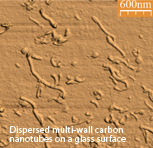Home > Press > Making the most of carbon nanotube-liquid crystal combos: Physical response of combination materials made of nanotubes with ferroelectric liquid crystals could lead to new applications
 |
Abstract:
Dispersions of carbon nanotubes with liquid crystals have attracted much interest because they pave the way for creating new materials with added functionalities. Now, a study published in EPJ E by Marina Yakemseva and colleagues at the Nanomaterials Research Institute in Ivanovo, Russia, focuses on the influence of temperature and nanotube concentration on the physical properties of such combined materials. These findings could have implications for optimising these combinations for non-display applications, such as sensors or externally stimulated switches, and novel materials that are responsive to electric, magnetic, mechanical or even optical fields.
Making the most of carbon nanotube-liquid crystal combos: Physical response of combination materials made of nanotubes with ferroelectric liquid crystals could lead to new applications
Heidelberg, Germany and New York, NY | Posted on April 2nd, 2014The added functionalities of these compound materials are achieved by combining the self-organisation of a liquid crystal with the characteristics of nanotubes, which exhibit a major difference in electric and thermal conductivity between their long and short axis. In this study, the authors focused on the electro-optic and dielectric properties of ferroelectric liquid crystal-multiwall carbon nanotube combinations.
Specifically, they studied the influence of temperature on the compound material's main physical properties, such as tilt angle, spontaneous polarisation, response time, viscosity, and the strength and frequency of its dielectric relaxation. They found that all dispersions exhibit the expected temperature dependencies with regard to their physical properties.
They also investigated the dependence of physical characteristics on nanotube concentration, which is still the subject of several contradicting reports. For increasing nanotube concentration, they observed a decrease in tilt angle, but an increase in spontaneous polarisation. This phenomenon explains the enhancement of the so-called bilinear coupling coefficient between tilt angle and spontaneous polarisation. Despite the increase in polarisation, the electro-optic response times slow down, which suggests an increase in rotational viscosity along the tilt cone. This phenomenon also accounts for the observed decrease in dielectric relaxation frequency for increasing nanotube concentration.
####
For more information, please click here
Contacts:
Saskia Rohmer
Springer
Corporate Communications
tel +49 6221 4878414
Copyright © Springer
If you have a comment, please Contact us.Issuers of news releases, not 7th Wave, Inc. or Nanotechnology Now, are solely responsible for the accuracy of the content.
| Related Links |
| Related News Press |
News and information
![]() Simulating magnetization in a Heisenberg quantum spin chain April 5th, 2024
Simulating magnetization in a Heisenberg quantum spin chain April 5th, 2024
![]() NRL charters Navy’s quantum inertial navigation path to reduce drift April 5th, 2024
NRL charters Navy’s quantum inertial navigation path to reduce drift April 5th, 2024
![]() Discovery points path to flash-like memory for storing qubits: Rice find could hasten development of nonvolatile quantum memory April 5th, 2024
Discovery points path to flash-like memory for storing qubits: Rice find could hasten development of nonvolatile quantum memory April 5th, 2024
![]() Good as gold - improving infectious disease testing with gold nanoparticles April 5th, 2024
Good as gold - improving infectious disease testing with gold nanoparticles April 5th, 2024
Display technology/LEDs/SS Lighting/OLEDs
![]() Utilizing palladium for addressing contact issues of buried oxide thin film transistors April 5th, 2024
Utilizing palladium for addressing contact issues of buried oxide thin film transistors April 5th, 2024
![]() Light guide plate based on perovskite nanocomposites November 3rd, 2023
Light guide plate based on perovskite nanocomposites November 3rd, 2023
![]() Simple ballpoint pen can write custom LEDs August 11th, 2023
Simple ballpoint pen can write custom LEDs August 11th, 2023
Nanotubes/Buckyballs/Fullerenes/Nanorods/Nanostrings
![]() Tests find no free-standing nanotubes released from tire tread wear September 8th, 2023
Tests find no free-standing nanotubes released from tire tread wear September 8th, 2023
![]() Detection of bacteria and viruses with fluorescent nanotubes July 21st, 2023
Detection of bacteria and viruses with fluorescent nanotubes July 21st, 2023
Sensors
Discoveries
![]() Chemical reactions can scramble quantum information as well as black holes April 5th, 2024
Chemical reactions can scramble quantum information as well as black holes April 5th, 2024
![]() New micromaterial releases nanoparticles that selectively destroy cancer cells April 5th, 2024
New micromaterial releases nanoparticles that selectively destroy cancer cells April 5th, 2024
![]() Utilizing palladium for addressing contact issues of buried oxide thin film transistors April 5th, 2024
Utilizing palladium for addressing contact issues of buried oxide thin film transistors April 5th, 2024
Announcements
![]() NRL charters Navy’s quantum inertial navigation path to reduce drift April 5th, 2024
NRL charters Navy’s quantum inertial navigation path to reduce drift April 5th, 2024
![]() Discovery points path to flash-like memory for storing qubits: Rice find could hasten development of nonvolatile quantum memory April 5th, 2024
Discovery points path to flash-like memory for storing qubits: Rice find could hasten development of nonvolatile quantum memory April 5th, 2024
Interviews/Book Reviews/Essays/Reports/Podcasts/Journals/White papers/Posters
![]() Simulating magnetization in a Heisenberg quantum spin chain April 5th, 2024
Simulating magnetization in a Heisenberg quantum spin chain April 5th, 2024
![]() Discovery points path to flash-like memory for storing qubits: Rice find could hasten development of nonvolatile quantum memory April 5th, 2024
Discovery points path to flash-like memory for storing qubits: Rice find could hasten development of nonvolatile quantum memory April 5th, 2024
|
|
||
|
|
||
| The latest news from around the world, FREE | ||
|
|
||
|
|
||
| Premium Products | ||
|
|
||
|
Only the news you want to read!
Learn More |
||
|
|
||
|
Full-service, expert consulting
Learn More |
||
|
|
||








